Edd Fuentes: Collector of stories, primitive art & rice gods

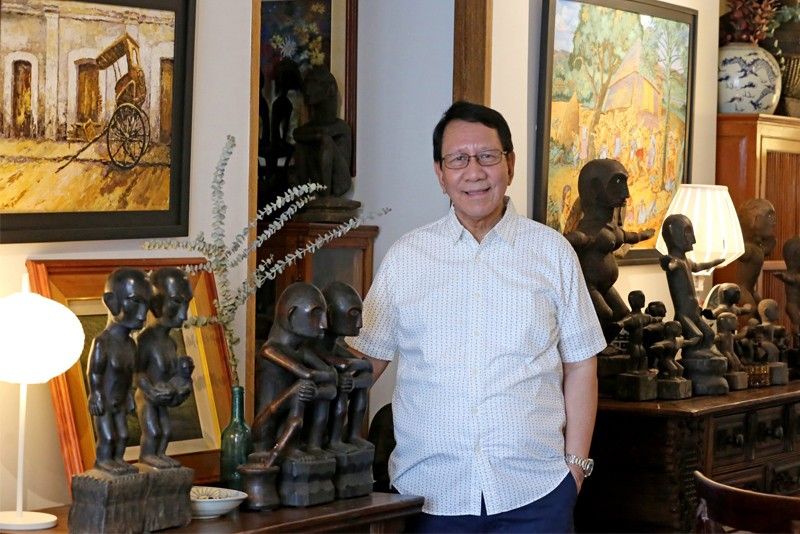
PR man Edd Fuentes’ home is a preview of his bulul collection. There are rice gods standing up, sitting down, dancing, having sex, bearing children, carrying vessels — each of them sparking joy in him.
His home is surrounded by some of the newest and most expensive condominium buildings in Makati. But if you close your eyes for a minute and focus on the things inside when you open them again, you would be transported one hundred years into the past — to Ifugao province in the Cordillera region.
Public relations guru Edd Fuentes can easily imagine himself living in that period, in that place surrounded by rice terraces where the valleys are green and rocky rivers run through them because his home is filled with Ifugao stories, primitive art and their gods of rice.
There are gods standing up, sitting down, dancing, having sex, bearing children, carrying vessels for rice, spices, wine, betel nuts — and in all sizes.
Edd is a familiar name and face in media and PR, representing top lifestyle and corporate clients. He is president and CEO of FuentesManila, which he established in 1990. For the past five years, he’s sat on the board of IPRA (International Public Relations Association), based in London and the world’s largest association of senior PR practitioners. He’s the first Filipino to be a board member representing Eastern Asia. He also owns three boutique resorts in Boracay under the brand Sun Villas.
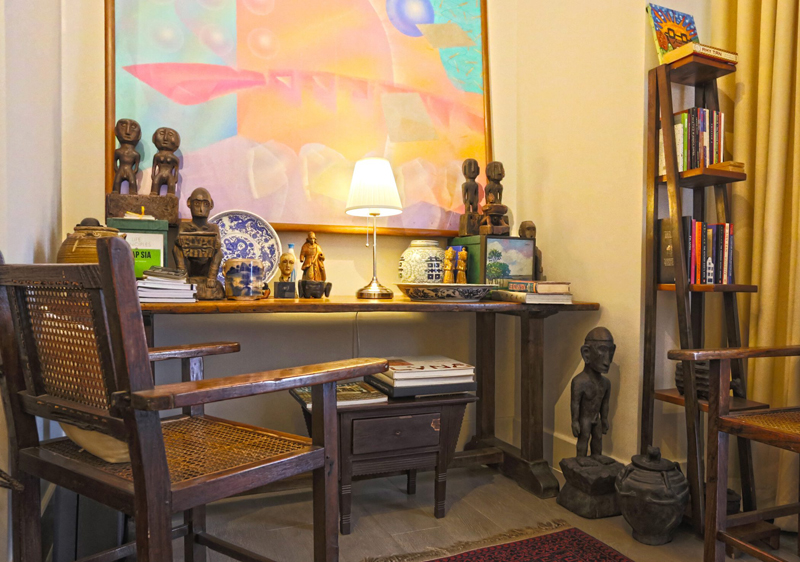
The writing corner of his bedroom has a sulihiya chair and a step ladder turned into a bookshelf.
What not everyone knows, however, is that he’s also a collector of Philippine primitive art, specifically bululs from Ifugao. He has accumulated 2,000 pieces in five decades and in his new 120-sqm. home, which he moved into last December, he has 200 pieces or 10 percent of his collection (the rest are in a warehouse).
Even Marie Kondo will have an especially difficult time de-cluttering this space because as Edd says with a hearty laugh, “Every single one of these bululs sparks joy.”
Indeed, they have been giving him joy since the 1970s, when he started collecting them. It wasn’t supposed to be bulul — it wasn’t even supposed to be anything.
But when Edd would travel to the provinces, the first place he’d go to was the palengke. “Because that’s how you learn about the place. Then I would see their crafts — new ones, not old. At the time I was still living in my mother’s house in BF Homes in Parañaque, napuno ko ng baskets! Sabi ng nanay ko, ‘Ang hirap namang maglinis dito.’ Dust gatherers yan eh.
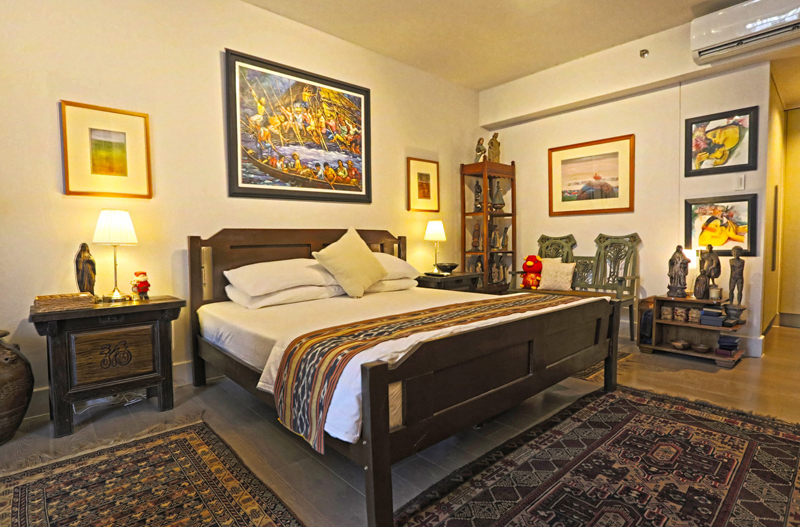
Edd moved into his new condo without buying anything new except for this custom-made wooden bedframe topped with an ikat runner. The side tables are vintage Japanese rice containers.
“Once, when I went to Baguio I discovered the old baskets. Little by little, I got exposed to them and learned the stories behind them — whether they’re true or not, there’s always a story attached to a piece but pretty soon you can tell what’s a tall tale. So dumami na yung mga gamit ko, then somebody offered me a space in Manila and I opened a small shop. That’s how I started dealing antiques.”
His shop was on Mabini St. in Ermita (his second shop was at Casa Manila in Intramuros) and just like that he was back in the area he loved best as a child.
Ermita was his stomping ground from his childhood to teenage years. He used to spend his days in the libraries of Manila City Hall and USIS (United States Information Service) reading all the classic literature. While kids outside played, Edd was scouring the bookshelves for Russian, American and British literature.
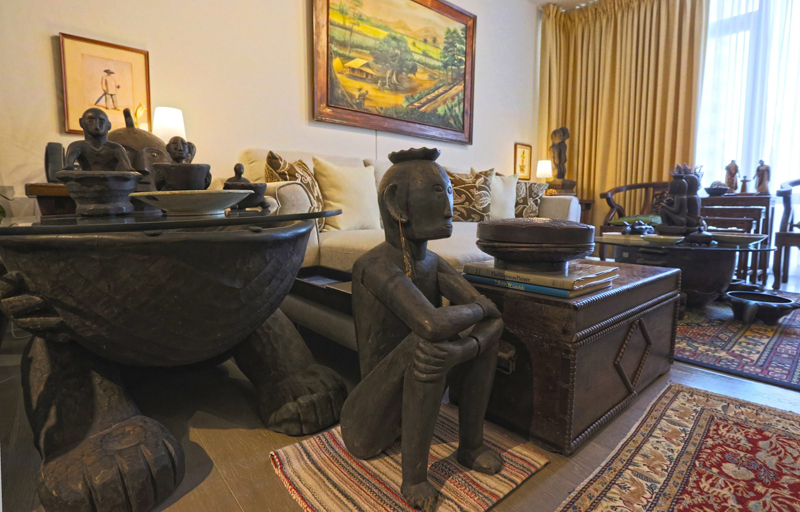
The base of the side table in the living room is a ceremonial bulul holding a huge wine container. On top are smaller versions for spices.
We wonder if — as he got lost in the pages of his favorite books by Hemingway, Frost, Dickinson, Steinbeck, Faulkner and Fitzgerald — he had any indication then of just how far back his love for the past would take him.
In the 1970s, he says, the international antique trade was big business. Dealers were into Orientalia and after having glutted the US and European markets with Chinese, Korean and Japanese antiques, they started looking southeast and discovered Philippine primitive art.
“I was one of the first ones to start dealing in tribal arts. At the time, the ‘rich look’ was the santos made from ivory; ako naman, provincial primitive.
“I would ship containers to France, Germany, the US and the rest of Europe. Most of my customers were dealers and they weren’t buying the heavily ornamented pieces, they were buying primitive ones. The market was really booming.”
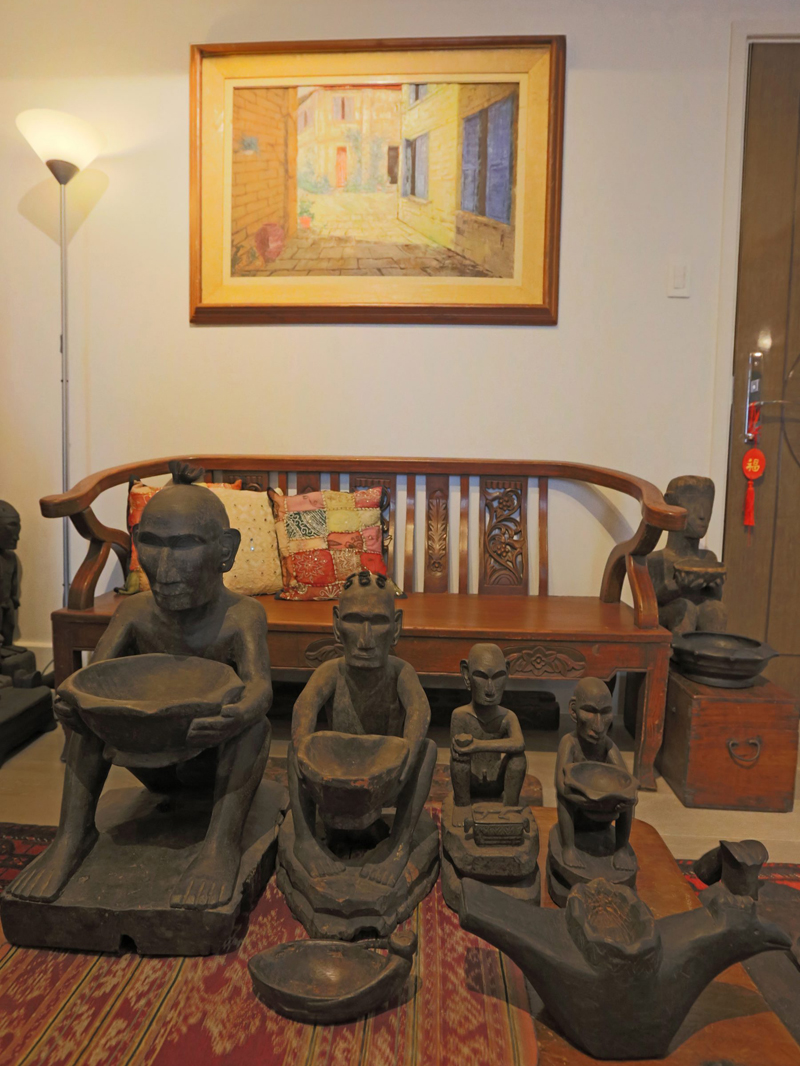
Edd mixes this space with Chinese-motif vintage furniture from Batangas and bululs from the highlands.
In that period when there was money to be made, reproductions — not the obvious tourist souvenirs — were also being made.
In 1990, when he opened his own PR firm, Edd closed his antique shop — but he continued collecting bululs, a little bit of santos and paintings by Filipino masters.
“I stopped buying santos because I felt at a certain point that you cannot collect everything. Unless something really beautiful came along, I stopped seeking it.”
A decade later, Edd would find himself in Provence, France where a trade contact brought him to a palatial house, and there he saw his old pieces.
“It was a three-story modern houses surrounded by fields and inside the house were the Philippine primitive art that I had sold, including a huge wooden batya they were using as a magazine container.”
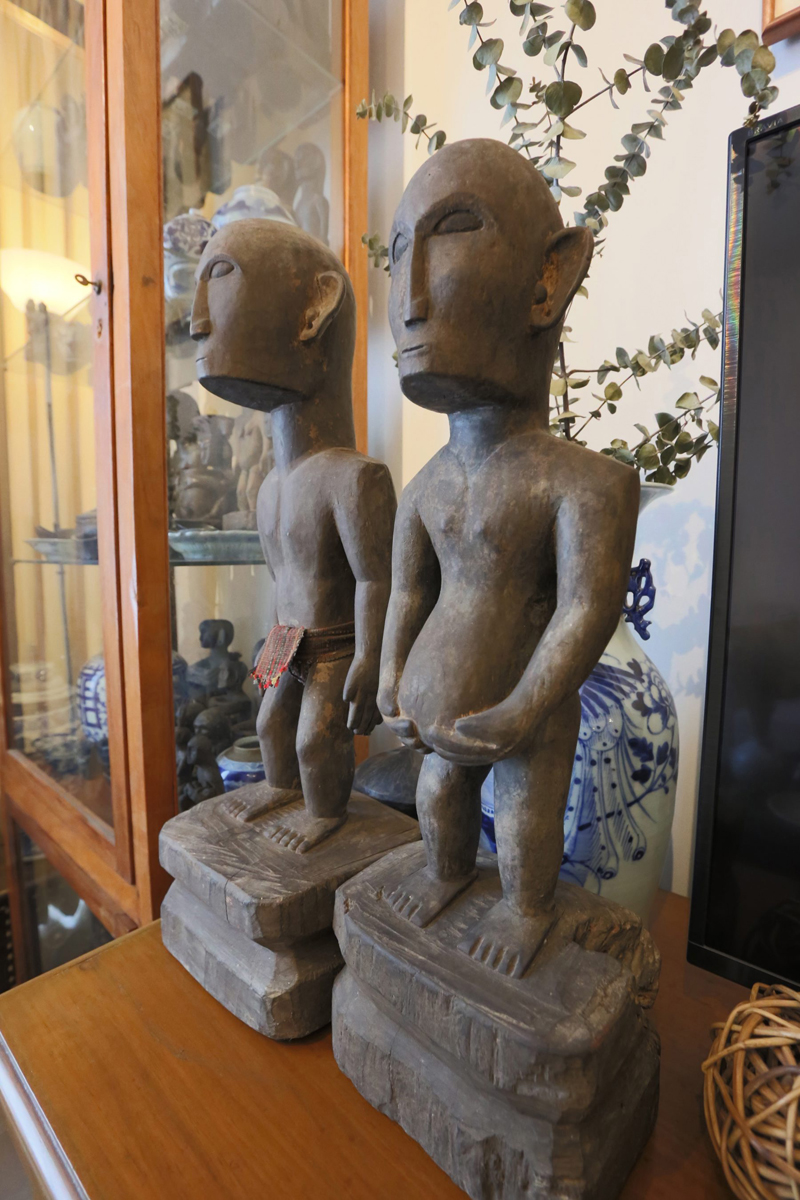
Bululs come in pairs, this one with a pregnant female.
Edd’s two-bedroom unit in Makati is an homage to Ifugao province, his past travels to the Cordilleras and the century past.
An étagère containing undressed santos in his bedroom used to be a pillow rack in a typical Ifugao house. “People would sleep on woven mats and at daytime they would stack their pillows in this rack.”
A towel holder in the bathroom used to be a ladder. Antique Japanese rice containers are now side tables.
In the living room, vintage Chinese-motif chairs from Batangas are mixed with a contemporary sofa and a glass-topped dining table.
Having moved here from another condo that was half the present’s size, he did not by anything new except for the wooden bedframe and mattress.
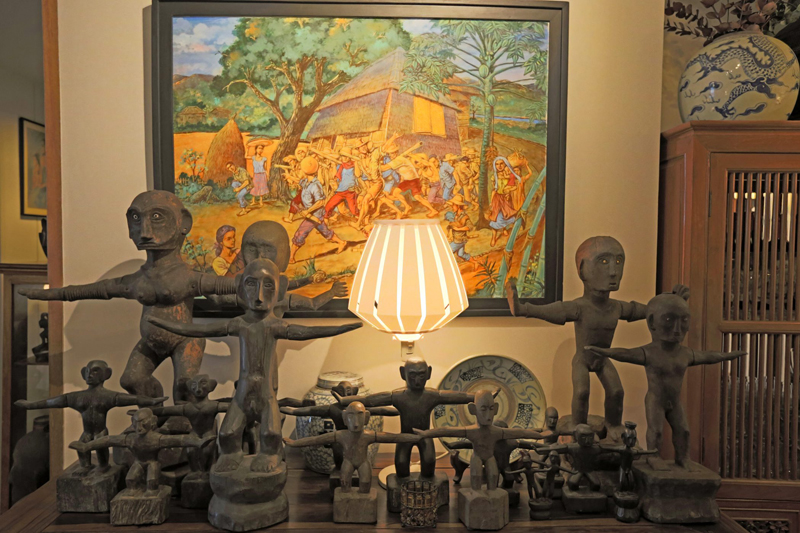
Dancing bululs: A bulul is “carved from one piece of wood, mostly narra, molave and what the locals call iron wood, which is very heavy, and grows only in the highlands.”
It is the living room that truly showcases the scope and depth of his bulul collection. They are everywhere — on the floor, on the coffee table and coromandel, on shelves and glass cabinets.
What are the smallest and biggest pieces in his collection? He takes one out of a glass cabinet and holds it up — it’s a dancing rice god 2.5 inches tall; the biggest is in his warehouse — a five-foot-tall bulul that, in another time, found its purpose in the rice fields to guard the fields and make them bountiful.
Then something catches my eye — the side table is topped with glass and the base is a full-figure female bulul seated on the floor with a huge vessel.
“That’s a ceremonial piece,” Edd explains. “They used that for weddings to hold the wine and guests would just scoop from it; think of it as an ancient punch bowl. That’s why some pieces have a patina of red, that’s from the wine.”
Atop this are smaller versions used in the kitchen for spices. Some of his bululs are darker than others and Edd says that’s from soot, which indicates they were placed in the kitchen.
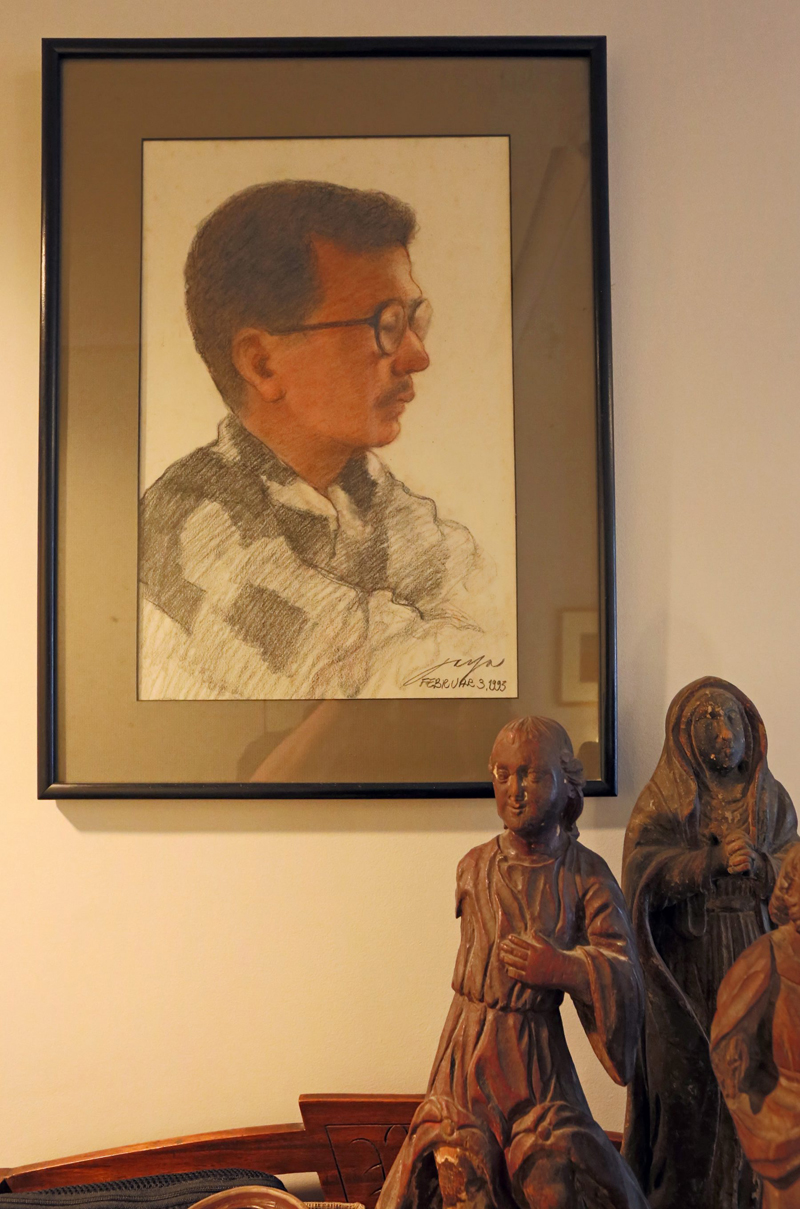
A portrait of Edd by Jose Joya, 1993, with two santos. “I stopped buying santos because I felt at a certain point that you cannot collect everything.”
Bulul figures always come in pairs — a male and a female. The males have their penises erect while the females have holes in their ears and you’re lucky if you buy one with the original wooden earrings.
Edd has several pairs where the female is pregnant. There is a certain gentleness to this figure, to the curve of the stomach heavy with child.
I point to another pair and say, “Oh, how cute, they’re embracing.”
Edd laughs and corrects me, “They’re having sex!”
Indeed, the woman is actually straddling the male figure. But there is no expression on either of their faces.
To the untrained eye, one bulul looks like another except for their poses, but these rice gods have different purposes apart from bringing abundance; some are for fertility, others are for healing and protection.
One thing they have in common is that “all of them are carved from one piece of wood, mostly narra, molave and what the locals call ‘iron wood,’ which is very heavy and grows only in the highlands.”
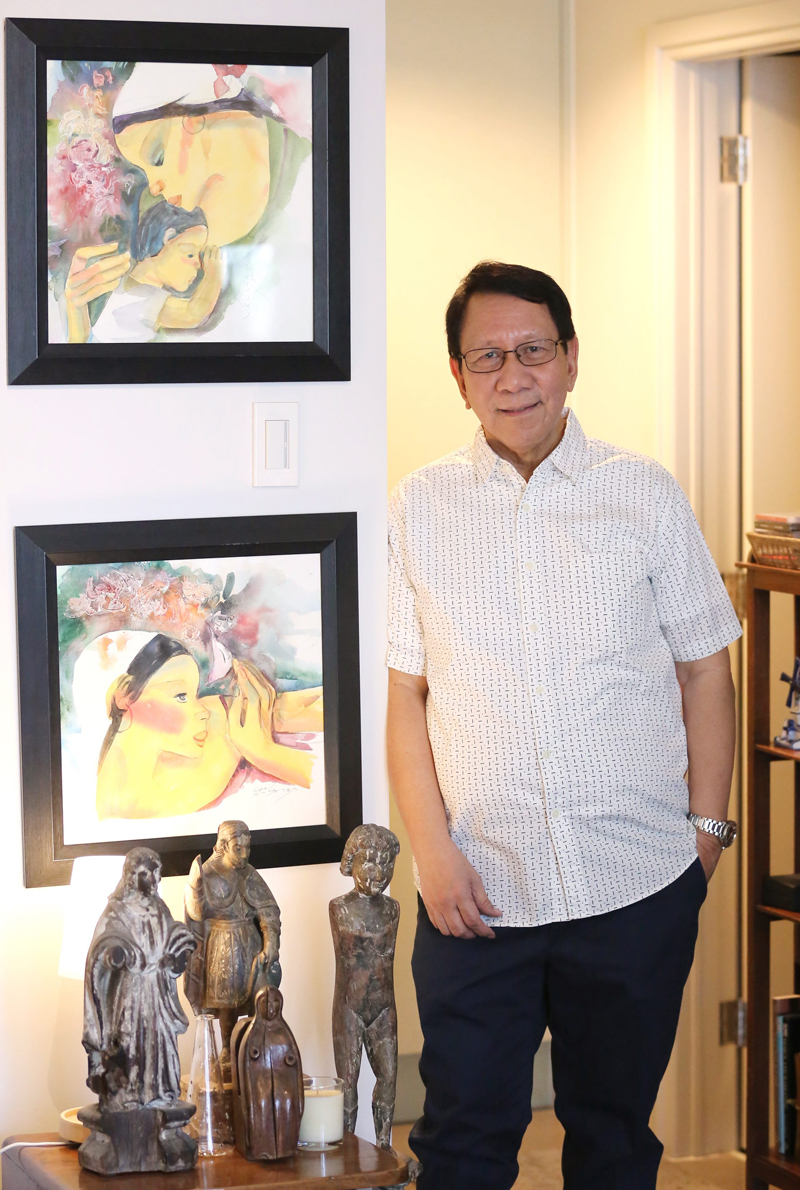
PR guru and Sun Villas Resort owner Edd Fuentes: His collection of paintings include works by Lydia Velasco (above), Joya, Lamarroza, Olazo, Sanso, and young unknown painters.
Another differentiator is the price, of course. In general, new pieces average P30,000 while vintage and antiques can range from hundreds of thousands to millions of pesos.
The level of detailing also varies: some have eyes that are simply slits, others have eyelids.
Edd explains, “The primitive ones, walang detailing sa mukha. The first recorded carver, in 1850 to 1920, was Taguiling. He was a master carver and he had a lot of students. After that, marami nang gumaya. Some people will try to sell me a piece, saying, ‘Sir, Taguiling yan, but I’d say, hindi that’s made by his students Boboyongan or Kimmayong.
“Taguiling’s peak years were during the turn of the century. He was the one who revolutionized the carving from primitive to almost life-like faces. His inspiration was the American soldiers. Remember, when America took over the Philippines they went to the mountains, so you can see that in the (pointed) noses. The pieces were never signed, just like unsigned paintings by the masters.”
He says that to determine their authenticity you must have experience for years and studied them.

“Every single one of these bululs sparks joy.”
“Sometimes all the elements are there so even if it’s unsigned you know it was done by a certain artist. Like a painting, you’d study the strokes.”
Doesn’t he ever get overwhelmed by his collection? Edd laughs and says, “Sometimes I do. I ask myself, ‘What am I doing?’ There are times I don’t even want to look at anything the dealers offer me.”
Yet he still finds it hard to resist “especially kung maganda. Collecting is like being addicted to gambling. Kahit marami ka na, you’d still buy.”
One of these days, he promises himself, he will catalogue his collection, examine which pieces he wants to keep and which ones he can dispose of in a warehouse sale.
Sometime in the future. Maybe it will happen, maybe not. When it does, when he’s ready, maybe that moment will spark joy, too.
* * *
Visit the author’s travel blog at www.findingmyway.net. Follow her on Twitter and Instagram @iamtanyalara.



















